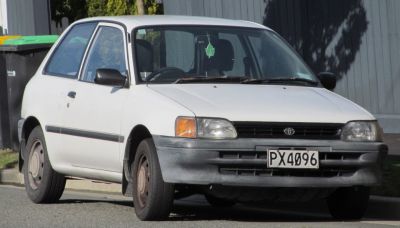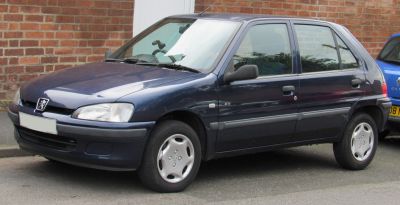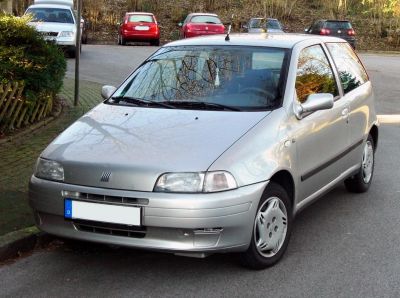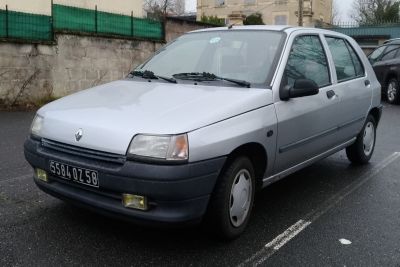 1994 Fiat Punto I (176) Dimensions, Size & Specs
1994 Fiat Punto I (176) Dimensions, Size & SpecsMeasurements of the 1994 Fiat Punto I, engineered for optimal performance and comfort
| Dimensions | |
|---|---|
| Length: | 3760-3770 mm148.0-148.4 in12.3-12.4 ft |
| Width: | 1625 mm64.0 in5.3 ft |
| Height: | 1450-1460 mm57.1-57.5 in4.8-4.8 ft |
| Trunk Capacity: | 275 liter9.7 cu ft |
| Trunk Capacity (Max): | 1080 liter38.1 cu ft |
| Weight Specifications | |
| Curb Weight: | 842-1010 kg1856-2227 lbs |
| Maximal permitted Weight: | 1300-1460 kg2866-3219 lbs |
| Tire Specifications | |
| Rims Sizes: |
|
| Tire Sizes: |
|
The Fiat Punto I (176) hatchback, produced between 1993 and 1997, marked the Italian automaker's commitment to providing a compact, stylish, and practical urban vehicle. This first-generation Punto fits comfortably into the subcompact segment, combining maneuverability with useful interior and cargo space ideal for city driving and light travel.
Dimensionally, the Punto I measures approximately 3760 to 3770 mm (148 to 148.4 inches) in length, making it a compact option for navigating tight streets and parking spaces. Its width stands at 1625 mm (64 inches), offering a stable road presence without compromising easy handling. The height ranges from 1450 to 1460 mm (57.1 to 57.5 inches), contributing to a relatively upright cabin that maximizes headroom and comfort for passengers.
Weight-wise, the curb weight spans from 842 to 1010 kg (1857 to 2227 lbs), reflecting its light and efficient construction. The vehicle's maximum permitted weight ranges from 1300 to 1460 kg (2866 to 3219 lbs), accommodating passengers and cargo effectively.
Storage versatility is a notable feature, with a standard luggage capacity of 275 liters (9.7 cubic feet), which expands to a generous 1080 liters (38.1 cubic feet) when the rear seats are folded down. This flexibility makes the Punto I practical for both everyday errands and longer trips that require additional cargo space.
The car rides on tire options sized between 13 and 14 inches, including 185/55 R14, 165/70 R13, 175/60 R14, 155/70 R13, and 165/65 R14, mounted on matching 13- or 14-inch rims. This variety provides choices that balance ride comfort, handling, and road grip.
Overall, the Fiat Punto I (176) hatchback is a well-rounded subcompact vehicle that offers compact dimensions for urban ease, a lightweight frame for fuel efficiency, and flexible cargo space, making it an excellent choice for drivers seeking a practical and economical car in the mid-1990s automotive landscape.
Discover the standout features that make the 1994 Fiat Punto I a leader in its class
Have a question? Please check our knowledgebase first.
The Fiat Punto I (176), produced from 1993 to 1997, features a length ranging between 3760 mm and 3770 mm (approximately 148.0 to 148.4 inches). It has a width of 1625 mm (about 64.0 inches) and a height between 1450 mm and 1460 mm (around 57.1 to 57.5 inches). These compact dimensions make the Punto I a practical city car that is easy to maneuver and park, balancing interior space with an overall small footprint suitable for urban driving.
The Fiat Punto I (176) has a curb weight ranging from 842 kg to 1010 kg (approximately 1857 to 2227 lbs) depending on the specific configuration and trim. Its maximum weight ranges between 1300 kg and 1460 kg (around 2866 to 3220 lbs). The relatively low curb weight contributes to nimble handling, good fuel efficiency, and ease of driving, especially in urban environments. The maximum weight includes passengers and cargo, ensuring the car maintains its stability and safety standards when fully loaded.
The Fiat Punto I (176) offers a luggage capacity of 275 liters (approximately 9.7 cubic feet) with the rear seats in the upright position. When the rear seats are folded down, this expands significantly to 1080 liters (about 38.1 cubic feet). This flexibility allows the Punto to accommodate larger items when needed, which is especially useful for families or individuals requiring extra cargo space for trips or shopping, while still maintaining a compact size for day-to-day driving.
Yes, the Fiat Punto I (176) comfortably fits into a standard garage. Standard garages typically have widths of around 2400 mm to 3000 mm (94.5 to 118 inches), depths of about 4800 mm (189 inches), and heights exceeding 2000 mm (78.7 inches). With a width of 1625 mm (64 inches), length of roughly 3760-3770 mm (148 to 148.4 inches), and height between 1450 mm and 1460 mm (57.1 to 57.5 inches), the Punto leaves ample clearance on all sides, allowing easy parking and opening of doors inside a standard-sized garage.
The Fiat Punto I (176) is compatible with several tire sizes including 185/55 R14, 165/70 R13, 175/60 R14, 155/70 R13, and 165/65 R14. Correspondingly, the rim sizes available are 13 and 14 inches. Smaller rims with higher-profile tires (e.g., 13-inch rims with 165/70 tires) typically provide a softer ride with more cushioning over bumps, ideal for comfort. Larger rims with lower-profile tires (14-inch rims with 185/55 tires) usually enhance handling and cornering performance but may transmit more road imperfections to the cabin.
The Fiat Punto I (176) was introduced as a replacement for the Fiat Uno, bringing a fresh design and modern engineering. In terms of size, the Punto is slightly more compact with a length around 3760-3770 mm compared to the Uno's approximately 3700 mm, making it easier to maneuver in tight urban environments. The Punto featured improved aerodynamics, a more contemporary hatchback aesthetic, and enhanced interior ergonomics. Additionally, it offered more efficient engine options and better safety features, reflecting advancements in automotive technology during the early 1990s.
The Fiat Punto I (176) fits well within the small hatchback segment of the 1990s, sharing similar dimensions and weights with competitors such as the Ford Fiesta Mk3, Volkswagen Polo Mk3, and Peugeot 206. With lengths around 3.76 meters, widths of 1.62 meters, and weights ranging from 842 to 1010 kg, it is comparable in footprint and agility. However, the Punto often stood out for its spacious interior relative to its compact external dimensions and its highly efficient use of space, making it a practical choice among contemporaries for urban and suburban driving.
The Fiat Punto I (176) has a height varying between 1450 mm and 1460 mm (approximately 57.1 to 57.5 inches). This moderate height provides a good balance between interior headroom and exterior aerodynamic efficiency. For occupants, the height contributes to comfortable headroom inside the cabin, accommodating most adults without feeling cramped. Aerodynamically, a lower height helps reduce air resistance, improving fuel efficiency and stability at higher speeds, making the Punto both practical and economical for everyday driving.
The Fiat Punto I (176) measures 1625 mm (about 64 inches) in width. This relatively narrow width enhances its ability to navigate and park in tight urban spaces, a distinct advantage in crowded city environments. While the narrow body helps with maneuverability, Fiat optimized the interior layout to maximize passenger space, making efficient use of the width to offer a comfortable cabin for both front and rear passengers. This width strikes a good balance between on-road agility and passenger comfort.
The relatively light curb weight of the Fiat Punto I (176), between 842 kg and 1010 kg (1857 to 2227 lbs), positively influences its fuel economy and performance. Lower vehicle weight reduces the energy required for acceleration and maintaining speed, which improves fuel efficiency—a big advantage for city and suburban commuting. The light weight also enhances handling and braking responsiveness, resulting in a more agile driving experience. This makes the Punto suitable for drivers seeking an economical yet nimble small car.
Discover similar sized cars.

| Production: | 1989-1996 |
|---|---|
| Model Year: | 1990 |
| Length: | 3720 mm146.5 in |
| Width: | 1600 mm63.0 in |
| Height: | 1380 mm54.3 in |

| Production: | 2006-2011 |
|---|---|
| Model Year: | 2006 |
| Length: | 3810 mm150.0 in |
| Width: | 1704 mm67.1 in |
| Height: | 1510-1530 mm59.4-60.2 in |

| Production: | 1996-2003 |
|---|---|
| Model Year: | 1996 |
| Length: | 3680 mm144.9 in |
| Width: | 1590-1610 mm62.6-63.4 in |
| Height: | 1357-1380 mm53.4-54.3 in |

| Production: | 1997-1999 |
|---|---|
| Model Year: | 1997 |
| Length: | 3760-3770 mm148.0-148.4 in |
| Width: | 1625 mm64.0 in |
| Height: | 1440-1460 mm56.7-57.5 in |

| Production: | 1974-1983 |
|---|---|
| Model Year: | 1974 |
| Length: | 3723 mm146.6 in |
| Width: | 1610 mm63.4 in |
| Height: | 1410 mm55.5 in |

| Production: | 1974-1983 |
|---|---|
| Model Year: | 1974 |
| Length: | 3723 mm146.6 in |
| Width: | 1610 mm63.4 in |
| Height: | 1410 mm55.5 in |

| Production: | 1990-1998 |
|---|---|
| Model Year: | 1990 |
| Length: | 3709 mm146.0 in |
| Width: | 1616 mm63.6 in |
| Height: | 1395 mm54.9 in |

| Production: | 2023-present |
|---|---|
| Model Year: | 2023 |
| Length: | 3810 mm150.0 in |
| Width: | 1680 mm66.1 in |
| Height: | 1485 mm58.5 in |
